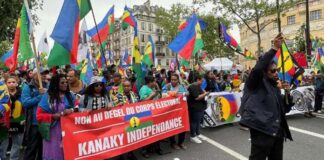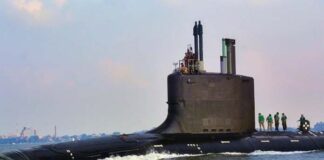Tom Orsag looks at Australia’s seizure of German Pacific colonies during WWI and how this motivated Australian involvement in the war
Despite the nationalist focus on deaths at Gallipoli in 1915 as part of Anzac commemorations, Australia’s first casualties in WWI came in the South Pacific.
Six Australian soldiers died in September 1914 fighting near Rabaul in New Guinea, along with German troops and 33 New Guineans on the German side.
Australia’s rulers were quick seize what Pacific territory they could when war broke out in the hope of holding onto it at the end of the war.
The Australian ruling class had coveted a Pacific empire since the 1870s and 1880s, as the emerging Australian ruling class began to realise that it had distinct interests. Although under the umbrella of the British empire, it would have to push Britain into looking after Australia’s interests in the south Pacific.
Australia was emerging as a regional sub-imperial power.
Today many people view WWI as a historical accident, while others claim it was a legitimate war against German aggression, fought for the rights of small countries like “plucky little Belgium”. In reality it was a clash between European powers competing to carve up the world into rival colonial empires.
Australia and New Zealand were no different. Their plan to seize German Pacific islands was already drawn up prior to 1914.
Their interest in the colonies was primarily strategic, as part of excluding rival imperial powers. The money to be made from them by Australian traders like Burns Philp and W.R. Carpenter was an added bonus.
Plans were drawn up in October 1912 to seize German colonies in New Guinea, Samoa and other smaller Pacific islands including Nauru.
This harked back to an 1896 Australian Inter-Colonial Military Committee recommendation that, “Instead of thinking in terms of the continent and Tasmania…the defence region of Australia be extended to include New Zealand, New Caledonia, the New Hebrides [Vanuatu], New Guinea and portions of Borneo and Java [Indonesia’s main island].”
NZ Defence Minister Allen approved plans drawn up by NZ’s military commander, Major-General Godley. One month later they were passed onto Australia’s military commander Brigadier-General Gordon, at a joint conference in Melbourne.
Allen then went to London and obtained the approval of the British War Office.
Germany’s colonies in the Pacific were totally unprepared for the outbreak of war. Apart from being thinly defended, they could not hold out long because they were totally dependent on Australia, New Zealand and East Asia for food supplies.
Australia assembled the most powerful naval force in the region, an Australian Naval and Military Expeditionary Force of over 1500 men.
The first Australian troop landings took place in September 1914 in New Guinea. The Germans surrendered within days. New Zealand captured Samoa and Australia occupied Nauru by early November.
After driving out Germany, their other concern was to limit Japanese expansion into the area.
Japan, as Britain’s ally, seized German colonies north of the Equator—the Carolinas, the Marianas (except Guam), the Marshall Islands and Palau.
Australia didn’t like this. But it had to bend to Britain’s insistence that Japan as an ally deserved the colonies.
Australia’s Pacific Monroe Doctrine
Australia had what it wanted south of the Equator, including phosphate rich Nauru, the “prize of the Pacific”, which Treasurer William A. Watt coveted for Australian agribusiness’s future, as what “the productivity of our continent absolutely depends on.”
As academic Nancy Viviani wrote, “Many Australian colonists on the eastern seaboard looked to New Guinea as their natural dependency, economically, politically and strategically, and regarded the Western Pacific as their natural sphere of influence.”
Queensland seized south-eastern New Guinea on behalf of Britain in 1883, worried that imperial rivals Germany and the Netherlands might stake a claim over the island.
The Melbourne Age summed up Australia’s sub-imperialist designs in May 1883, “It is at least as important to Australia that New Guinea should be annexed as it was that New Zealand should be secured. The unappropriated parts of the world are rapidly being seized upon…England can afford to disregard the extension of French colonies in distant areas [but] our security is at stake.
“Sooner or later it must come to something like a Monroe Doctrine for Australia; and we shall have to intimate unmistakably that no foreign annexations will be permitted in countries south of the [equatorial] line.”
The French designs on the New Hebrides (Vanuatu) in 1883 sent the now wealthier and more secure Australian colonies into a frenzy about a “foreign power” in the South Pacific, even though France had already occupied New Caledonia from 1853.
Australia’s political rulers had always had obsessive fears of Britain’s imperial rivals. Firstly it was France, dating back to the Napoleonic era. Then Russia after the Crimean War in 1853. Then Germany, as it emerged as the key rival in the 1880s.
When France wanted control over the New Hebrides, the Australian colonies united in one voice in public meetings in 1886 over the “New Hebrides crisis” and lobbied Britain at the Imperial Colonial Conference in 1887 to forestall France’s ambitions.
James Service, Premier of Victoria, was reported as telling the British at the Conference that, “It was Britain’s duty to dominate the Pacific, and particularly those islands which were of concern to Australia.”
Historian Jude McCullough wrote that, “As they began feeling themselves more and more a distinct political entity, the presence of the French in the western Pacific began to assume vaguely sinister aspects in a strategic sense.”
Joint Anglo-French rule in the New Hebrides was the compromise forced on the French by the Australian colonies.
At the Federal Convention of 1891, Henry Parkes, so-called founding father of Australia, revealed what the project of united Australia meant when he said, “Australia ought to be the mistress of the Southern Seas. The trade, the commerce…of these groups of rich islands ought to centre in our ports; and with these advantages, we ought to hold mastery of the hemisphere.”
In 1894, Victoria supported New Zealand’s demand that Britain annex Samoa, calling it the “manifest destiny of Australasia to be the controlling power in the Southern Pacific.”
Japan
By the 1890s, Australia’s designs in the Pacific meant that Japan came to be seen as a threat. That year Japan successful invaded the Chinese island of Formosa (Taiwan).
That fear turned to paranoia with Russia’s naval defeat in May 1905 in Battle of Tsushima, in Russo-Japanese war of 1904-5.
Sir Edward Hutton, General Officer Commanding the Military Forces, opined, “It is impossible to view the military situation in Australia…without grave misgivings. The victories of Japanese arms within the last four months have astounded the whole civilised world.”
Hysteria reigned when Japan annexed Korea in May 1910. Australian journalists ludicrously asked the new Japanese consul-general, on his arrival in Sydney in October, about the likelihood of a Japanese attack on Australia. This despite Britain and Japan renewing and extending an alliance treaty in 1905!
Australia and New Zealand’s fear of Japan and misgivings about Britain withdrawing from the Pacific set into motion the armament of Australia as “militarily the strongest of the British Dominions.”
Between 1902-03 and 1913-14, Australian defence spending increased more than six-fold, from £750,000 to over £4.7 million. In the last national budget before the war, defence spending accounted for almost 31 per cent of total government spending.
This was a higher percentage than in any other British Dominion. And more in both absolute and per capita terms than was spent by a comparable European country, such as the Netherlands.
Having taken possession of the German colonies, Australia and New Zealand were determined to keep control of them.
PM Billy Hughes had to insist on this at the Peace Conference in 1919 in Versailles, at the club of imperial powers.
In the lead-up, Hughes gave lectures at the Savoy Hotel in New York in May 1918 and the Pilgrim Club, London in July 1918.
Hughes said, “If Australian is to continue a free Commonwealth she must have guarantees against future aggression. This involves the Australian Monroe Doctrine in the South Pacific…We are committed by inexorable circumstances to the doctrine of ‘Hands off the Pacific’.”
Australia was granted a Class C Mandate under the League of Nations (forerunner to the UN) giving it control of Germany’s former South Pacific colonies.
The added bonus was that Australian law became pre-eminent in its colonies, meaning the White Australia policy could be enforced there. This closed them to outside investment, commerce or immigration—such as from Japan.
The new administrators of Australian-mandated New Guinea and New Zealand-mandated Samoa were all military men. One of the first orders was that the flogging for breaches of labour discipline be increased. Munro Ferguson, Australia’s Governor-General, said, “It was essential that the native should be made to respect and fear his white master.”
The Australian ruling class’s own interests in the Pacific drove their decision to send troops to the battlefields of Europe and the Middle East too.
Major E.L. Piesse, Director of Intelligence in the PM’s Department during the war, wrote that PM Billy Hughes, “had in mind not only the war in Europe but…Japan.”
Piesse recalled that when Hughes addressed a secret sitting of both Houses of Parliament he told them, “Japan would challenge the White Australia Policy after the war, that Australia would then need the help of the rest of the Empire, and that if she wished to be sure of getting it she must now throw her full strength into the war in Europe.”
The desire to tie the country to a larger power continues today in Australia’s alliance with the US. And the desire to dominate the local region continues too, in the Australian government’s attitude to East Timor, Fiji, Nauru, PNG, the Solomon Islands and Tonga.
This imperialist game has only ever served the interests of Australia’s rich and powerful.





